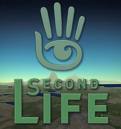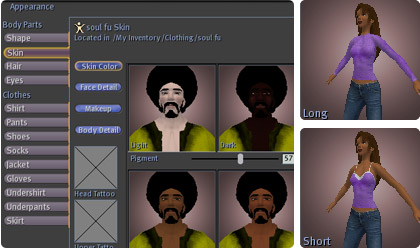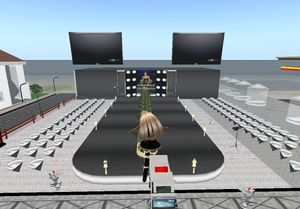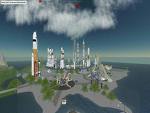T09 GROUP5
Contents
Living Online: The Virtual World of Second Life
Group Members
- Liam Potter
- Austin Hugh
- Phillipe Sylvestre
- Shi Jian Liu
Technology and Issues
Technology: Second Life
Issue: Online virtual world - Second Life and its affects on users' real world lives.
Online Community
Introduction
MySpace, Classmates.com, MSN Spaces, Facebook, Bebo, Friendster, Xanga...these website names should be quite familiar to Canadians, because they are Canadian's favorite social networking sites, according to 2007 OCLC Online Computer Library Center, Inc. survey. Social networking becomes a most popular trend of contemporary live. Interacting and creating activities take a large part among online activities, which construct many online communities where people involve in and interact with other people.
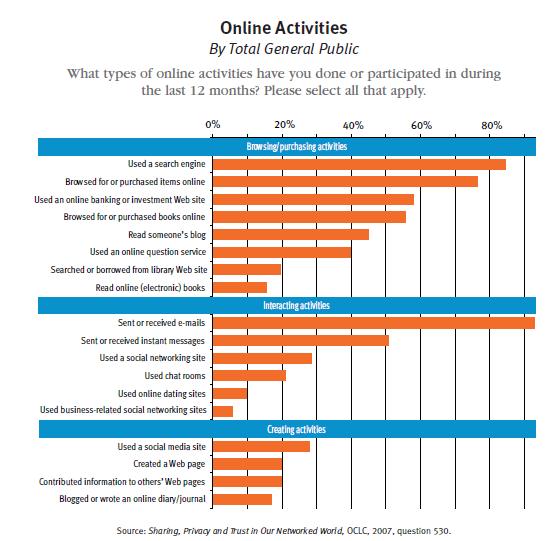
Online community, also called virtual community, enables people with similar interest, goal, and task to exchange information and life experiences, and to develop social relationships through a virtual space of Internet where is not restrict to geographical and organizational limitations.
Some common forms of online communities are:
1. E-mails
Electronic mail is the earliest form of people to communicate with each other by simple text messages. Users can create lists of receivers and sent their messages at one time. So it is a one to one or more interaction. Right now users can attach photos and files with their E-mails and sent E-cards. People are not necessary to communicate at a same time point but can reply messages whenever they want.
2. Instant messengers
Instant messengers are real-time communication through a same server, usually are one to one chat. Text is the base for instant messengers, but many other services have added to it with modern technology such as: the immediate receipt of acknowledgement or reply, group chatting, conference services (including voice and video), file transfer.
3. Personal blogs and spaces
Individual users post their commentary and description of events or feelings on a Website. Most of entries are very personal and well connected to users’ life. A blog or space contains text, pictures, and even music and videos that interest the individual who want to share with others and accepts mostly text comments from them.
4. Internet forum and chat rooms
Specific topics are discussed in internet forums and chat rooms. Internet forums are developed from Bulletin Board System (BBS)that users post their experience, tips, and tricks on how to overcome a particular problem, while chat rooms are well discussing on a particular events by users presenting on the same chat room.
5.Online video game
Although video games are widely believed to be gaming only, but modern online video games combine competition and communication together, which allow players to communicate with each other when gaming, enabling them to bargain on exchanging tools, or make to cooperate to get to a similar goal. It often leads to more intensive communication and relationship among these reliable groups of players.
Usenet
Usenet created the earliest form of online communities by using Bulletin Board System. Usenet was used before World Wide Web so it can only serve users connected to servers which were also linked. People sent out messages viewed by other users, who sent back their comments to their own server, which help to distribute the comments back. Usenet is very important to contemplate communication tools such as Web forums and chat rooms.
New Online Communities
As the revolution of web 2.0, which create an open ended, user modifying web design and technology, creativities by common users on websites become much easier to function. Communication online develops many other forms that enhance users’ collaboration and functionality of the web. Facebook, Youtube, Craigslist, Flickr, and Wikipedia introduce new forms of online communities.
Second Life
Introduction
Second Life is an online three dimensional community that was created by Linden Lab. Linden Lab released Second Life to the public in 2003. Everything in Second Life is created by the people that in habit this virtual world. Basic Membership to Second Life is free for everyone; however, a Premium Membership is offered for $9.995US per month. Second Life also has a virtual world for people ages 13-17 called Teen Second Life.
Getting Started in the Virtual World
Getting started in Second Life is simple. After you have signed up for a membership to Second Life you will have to create an avatar. This avatar will be the persona which will represent you in the virtual world. If you aren't satisfied with the look of one of the basic avatars that you will get select from don't worry you will be able to edit the appearance of your avatar at any time once you are in the virtual world. You may want to make your avatar reflect the person that you wish you were or maybe you want to make your avatar reflect who you are. Some people may even want to make their avatar the opposite gender of what they are in real life. How you want to look and who you want to be in the virtual world is completely up to you.
Economy of Second Life
Second life has it's own economy that is run on it's own currency. This currency is called the Linden dollar. The Linden Dollar can be exchanged for real currency in the Lindex exchange and also in certain third-party websites. The fact that real currency can be exchanged for Linden dollars and visa versa creates the opportunity for businesses to thrive and make real life profit in the virtual world. The exchange rate for the Linden dollar can be found in the Lindex exchange, which is the official exchange for Linden dollars of Second Life. Other economic graphs and statistics can be found on the Second Life website. People can buy, sell and trade the goods that they have created and that other residents have created within the economy of this virtual world, which causes the economy of Second Life to function like an economy in the real world.
Owning Land
Land can be purchased in Second Life; however, in order to own land you must be a Premium Member. The cost of owning land is not only the price of a premium membership each month but also a monthly Land Use Fee must be paid. This fee is based on the amount of land that is owned, which works similar to the property tax that you would pay on land in the real world. Although owning land costs money it may be profitable or may just be beneficial to the owner. Once you have purchased land you may create a private virtual oasis for yourself, open a business in an attempt to make real money in the virtual world and many other things on your land.
Entertainment for Your Avatar
After you have exchanged real currency for Linden dollars there are many ways for you to spend your money on your virtual self. If you want to improve the look of your avatar you could spend money on shoes, clothes or sunglasses. These are only a few examples of products that you can buy to change to look of your avatar. If you want to partake in some activities you could spend some money by going shopping, going to a night club or even racing go carts. These activities are again only a few examples of the many possiblities for entertainment in the virtual world. If you would rather go to an event you could go to an art opening, a concert or a fashion show. A list of all events that your avatar may attend can be found at any time by clicking on the "Search" menu and clicking on "Events". If going to a fashion show, shopping or racing go carts isn't entertaining enough for you then you may want to try taking a virtual trip around the world. Virtual travel in Second Life is easy and inexpensive. You can travel for free by simply flying or teleporting from one destination or another. So why not go see the Eiffel Tower and not even leave your chair.
Intellectual Property Rights
As everything in Second Life created by it’s inhabitants, when someone creates something they hold the Intellectual Property Rights for that product and can sell their creation, trade it or even give it away. Intellectual Property Rights are another very important aspect of Second Life because it allows for more opportunities for people to make real money in the virtual world buy selling their creations to fellow residents.
Negative Affects of Computer, Internet and Second Life Addiction
Introduction
We all spend time on the computer. In today’s society, it’s basically required of us to incorporate computers/internet in our everyday lives. Email, Facebook, University Blackboard, research for projects, etc. The list goes on as to how the internet is used in our everyday lives. However, a problem can arise when we very frequently use the computer/internet for activities and games that are not necessarily productive, but are time consuming.
The National Institute on Media and the Family says “When time spent on the computer, playing video games or cruising the internet reaches a point that it harms a child’s or adult’s family and social relationships, or disrupts school or work life, that person maybe caught in a cycle of addiction”.
Syptoms of computer addiction
Symptoms are both psychological and physical and can include:
- A sense of well-being or euphoria at computer
- Inability to stop the activity
- Craving more and more time at the computer
- Neglect of family and friends
- Failure to attend to personal hygiene
- Sleep disturbances
Second Life
Our other sections have already covered the inner workings of second life and what it consists of. From this knowledge, it can easily be seen how one could become addicted to something of this nature (especially those that feel socially inadequate, or incapable of experiencing a “typical” life through normal means. Ex. severely disabled). Second life allows you to accomplish, experience, and be what you may not be able to (or feel that you can’t) in real life. Whether it be because of shyness, nervousness, low self-esteem, poor communication skills, unattractive appearance, or just plain boredom. People from many walks of life can find Second Life very appealing, which can quickly turn to addiction if found more appealing than real life. Although Second Life itself is not the real world, its use of real money, realistic scenarios, and realistic economy brings a whole new side of internet gaming to the forefront.
Second Life supporters and users argue that it is in fact, not a “game” but a concept (living in the digital/virtual world). However, whether we consider Second Life to be a game or a concept is irrelevant. Either way it uses the computer and internet and has shown to be highly addictive to many and in that sense, some have called it the ultimate-cyber-addiction!
One blog discusses a radio station that aired the story of a man who told his father that he would go camping, he instead went to an internet cafe and played Second Life for 5 days straight without any rest. After 5 days people apparently found him dead lying on his chair. (http://star767.blogspot.com/2007/03/internet-games-and-addiction.html)
Although sad, this is how extreme addictions can be for some, so it is important to know the signs of internet addiction.
One source of help is through the Center for Internet Addiction Recovery at: www.netaddictionrecovery.blogspot.com
Benefits of Second Life
Introduction
The development of websites such as second life has proven to be a fascinating evolution in human interaction. With such advanced and creative technology, people are able to carry out nearly all of the same social functions as in real life, only without many of the constraints of reality. In Second Life, ones activities are not limited to their immediate environment – you are able to virtually interact with people and organizations from around the globe with ease, freely teleporting between different regions a user-imagined, virtual world. What results is an online society that blends fantasy and reality in unique, innovative and intriguing new ways
Education in Second Life
Over sixty educational institutions and organizations have set up shop in Second Life, exploring new ways it can promote learning. Major universities operating in SL include Stanford University, Texas State University, Diego State University, Emerson College, and even Harvard Law School. The great potential for experimental and distance learning in SL was recognized early on by leading educators, as virtual classrooms present the opportunity for enhanced interaction as well as the possibility for guest lecturers to teach classes from anywhere in the world. Many programs focused on media and technology use the site as a living case study in advanced communication, teaching simultaneously in and about virtual communities.
Business in Second Life
Second Life has a thriving multi-million dollar economy in which many major corporations operate. Companies like Coca-Cola sponsor virtual events, such as concerts and athletics; Sire Records uses the site for interactive record launches, involving fans, media, and the artists in ways that would not be possible in real life, and have even discovered and signed talent in from the virtual community; Reuters News Agency utilizes Second Life to enhance communications between its journalists around the world, and even has a full time correspondent reporting exclusively on in-world happenings
Many small and independant businesses also operate in Second Life, providing both physical and virtual goods and service. Many people are able to make a living solely from their Second Life enterprises, taking the e-bay business model to new levels.
Non-Profit Organizations
Linden Lab, the creators of Second Life, have made it easy for non-profit groups
to establish an online presence. Offering discounted land rates and mailing lists of in-world residents, SL creates a novel way for such groups to raise funds and awareness to their cause. The American Cancer Society, The Center For Disease Control, and Greenpeace are but a few of the organizations present in SL.


NASA
In May of 2008, The National Aeronautics and Space Administration established it’s own island/virtual space station in Second Life. A dedicated NASA team develops and utilizes the virtual space for educational purposes as well as to conduct simulated space missions, such as space walks and Mars landings. It is hoped that the site will one day serve as a communication device for astronauts to use while in space to interact with colleagues, friends and family back on earth.


Enhanced Interactive Social Networking
The possible directions websites like Second Life could move in are countless. People use the site for entertainment, friendship, online dating, business training, workshops and conferences, political interests, support groups for the severely disabled, substance abuse recovery services such as Alcoholics Anonymous, collaborative art and media projects, event promotion … The list continues to grow as quickly as the population and size of Second Life itself. Sites like Second Life appear to be the of future of the Internet – a logical development of the World Wide Web from independent websites towards a more life like interactive virtual universe, offering services and opportunities in ways that reflect our civilizations trend towards technological progress, improved efficiency, and increasingly sophisticated means of communication.
References
Shi Jian Liu
1. Sharing, Privacy and Trust in Our Networked World:-A Report to the OCLC Membership[1]
2. Risk Management 55.10 (Oct 2008):Jason Short
3."What is an "Internet forum"? (video entry by Ethan Feerst and Dylan Stewart group)
[2]
4.http://en.wikipedia.org/wiki/Blog
5.http://en.wikipedia.org/wiki/Virtual_community
6.http://en.wikipedia.org/wiki/Video_game_culture
Tallon Sylvestre
1.http://secondlife.com/
2.http://www.xstreetsl.com/modules.php?name=Marketplace
3.http://www.usatoday.com/tech/gaming/2007-05-11-virtual-vacation_N.htm
4.http://lindenlab.com/
5.http://www.time.com/time/magazine/article/0,9171,1570708,00.html
Austin Giles
1.http://www.mediafamily.org/facts/facts_gameaddiction.html
2.http://www.computeraddiction.com
3.http://star767.blogspot.com/2007/03/internet-games-and-addiction.html
4.http://www.emotionalwellbeingblog.com/2007/08/is-second-life-ultimate-cyber-addiction.html
5.http://elliptic.typepad.com/elliptic_blog/2004/01/second_life_add.html
Liam Potter
1.http://www.cnn.com
2.http://www.wired.com
3.http://www.businessweek.com
4.http://www.thehealthcareblog.com
5.http://www.secondlife.reuters.com
6.http://www.sciencedaily.com
